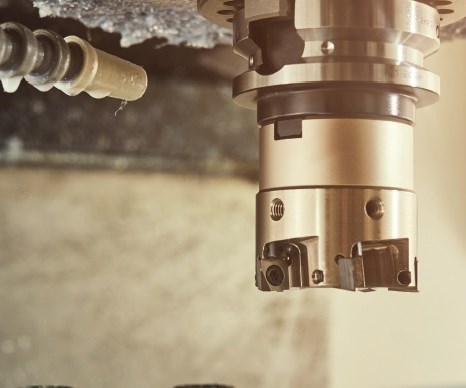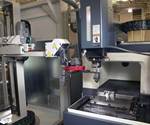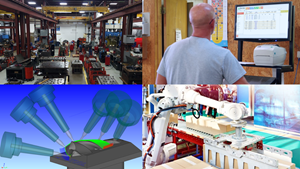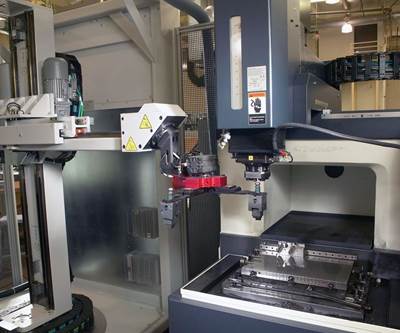5 Reasons to Consider Automation
As ongoing advances enable machines and humans to get better at talking to each other, eventually more shops will become more automated. If your shop hasn’t yet looked into upping its automation game, here are five reasons why you should.

Here are five big-picture considerations to shop automation.
1 To reduce labor costs.
Automation is already replacing human labor in areas such as picking and moving parts, assembly, inspection and more. Other examples where automation is producing significant reductions in labor costs include:
• BOM COMPARE. Reduces expensive engineering time by eliminating the manual comparing of CAD/CAM BOMs against existing BOMs in your ERP system.
• RFID. Improves the speed and reliability of employee software logins and inventory tracking.
• AUTOMATING PURCHASING. Reduces headcount in the purchasing department while lowering overall purchasing costs.
• HUMAN RESOURCES AND PAYROLL INTEGRATIONS.
Dramatically reduces HR personnel costs by managing employees and benefits in one system.
2 To eliminate waste.
In manufacturing, human error leads to wasted time and resources. Computers and machines can do many things faster and
more accurately than humans – without making mistakes.
• ACCURATE INVENTORY. Automating inventory processes such as picking parts and materials and lot tracking can turn accurate inventory from an
unfulfilled wish into reality. Automated equipment can also reduce lost or misplaced materials and minimize expiration or spoilage of inventory.
• LIGHTS OUT MANUFACTURING. An unused manufacturing plant at night is a wasted asset. Yet, the cost of running 2nd and 3rd shifts can be prohibitive. Automating your manufacturing systems puts your biggest asset to full use without the need for humans. Advantages of “lights out” manufacturing
include reduced labor, lighting, and HVAC costs while increasing throughput.
• REDUCE SCRAP AND REWORK. Even highly skilled operators can’t match the repeatable accuracy automation produces on routine or less complex
processes. Some automated machines can also perform multiple operations, eliminating the time required to move materials from one workcenter to
another.
• ELIMINATE PAPER. Paper documents slow down the production process by getting lost, misfiled or sent to the wrong person. With automated document
management, you can stop shuffling papers and start focusing your human capital on making decisions and creating value. When you digitally send the
right data to the right people at the right time, shop floor personnel no longer waste time hunting down routers, drawings, BOMs, POs, or inventory lists.
3 For lightning-fast turnaround times.
Automation lets you process orders faster, reduce setup and production times, and get your product out the door quicker. Check out these automation solutions:
• CAD INTERFACE. Enables the building of huge BOMs in a few hours rather than days or even weeks.
• NESTING INTERFACE. Reduces setup times and material waste by automatically arranging part shapes on bulk pieces of stock material.
• EDI. Cuts administrative time and costs for you and your customers with single-entry data transactions.
• ECOMMERCE INTEGRATION. Saves time for your customers by allowing them to order and pay directly from your website while automatically sending all job data to your ERP system.
4 To improve quality and safety.
Rework due to poor quality acts like an anchor on production time and lowers customer satisfaction. Workers’ comp costs can put large dents in your bottom line. Automating processes in these areas can raise quality ratings while making your workplace safer for employees. Automating quality procedures can help improve quality and reduce its cost at the same time by:
• Simplifying management of rework, rejects and scrap
• Reducing the amount of time to produce and implement engineering change notices
• Controlling every aspect of part revisions and inactivations through your ERP system
• Simplifying the process of qualifying for and maintaining ISO and other certifications
5 To future proof your business.
Automation improves the ability to forecast trends, see how customer needs will change, and prepare for them from a technology and strategy standpoint so you can get there ahead of the competition. Automating the data-gathering process with dashboards provides immediate access to accurate, real-time data while reporting or displaying it in any format you choose.
This allows you to:
• Identify trends with customers, products and your industry segment
• Analyze your business health by drilling down to any level of detail
• Forecast future customer needs and products/solutions to meet them
• Make faster, better decisions
Nobody can predict the future with certainty, but automation reduces the odds that the “next big thing” in your market will catch you off guard.
For More Information
Daniel Carranco is Director of Continuous Improvement for Global Shop Solutions.
Related Content
Quality Tool & Die Enhances Performance With Advanced EDM and Milling Technologies
The adoption of Mitsubishi wire and sinker EDMs, along with the OPS Ingersoll five-axis milling machine with automated cells, has enabled unmanned operations and improved precision. As a result, QTD has expanded its facility, grown its workforce and increased its business by 10-15% annually.
Read MoreDevelopments in High-Speed Machining Technology
There have been many exciting developments in high-speed machining relative to machining centers and controls, tooling and CAD/CAM systems.
Read MoreMMT Chats: Eliminating the Noise to Stay Focused on the Customer
Metro Mold & Design joins me to discuss the value of the 80/20 rule as a business strategy, its talented cross-functional team, the role of automation in mold building and molding, and the continuing impact of COVID-19.
Read MoreTool Paths, ERP & Improving Efficiency in Your Toolroom: What Did You Miss in February?
We covered a variety of topics in February. From tool paths to ERP and PTXPO coverage, we hope you didn’t miss anything but here is your cheat sheet if you did.
Read MoreRead Next
Adopting Automation
Shops are facing increased demand for shorter lead times, improved quality and lower costs. Automation offers several key advantages for overcoming these challenges.
Read MoreHow to Use Strategic Planning Tools, Data to Manage the Human Side of Business
Q&A with Marion Wells, MMT EAB member and founder of Human Asset Management.
Read MoreReasons to Use Fiber Lasers for Mold Cleaning
Fiber lasers offer a simplicity, speed, control and portability, minimizing mold cleaning risks.
Read More















.jpg;maxWidth=300;quality=90)







